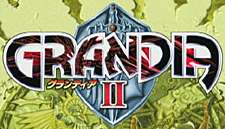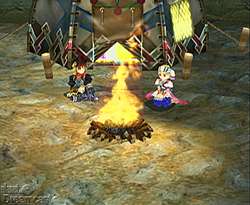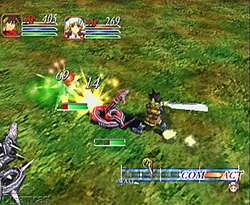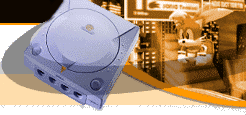| |
Grandia 2
The Dreamcast's second high-profile RPG makes for a fun (if familiar) adventure - Review By XianMrtyr
 Sherman, set the wayback machine for 1997. The skies were bluer then, an enthusiastic Bill Clinton was learning the joys of interns, and a game called Grandia took a nation by storm. This may seem like hyperbole, but when Grandia came out for the Sega Saturn in Japan, many hoped that its detailed and colorful world, its innovative combat system, and its then-astounding 3D environments would be able to rejuvenate interest in the ailing console. Sadly, the Saturn died an untimely death in America (and shortly thereafter, in Japan), and Grandia never reached American shores or systems.
Sherman, set the wayback machine for 1997. The skies were bluer then, an enthusiastic Bill Clinton was learning the joys of interns, and a game called Grandia took a nation by storm. This may seem like hyperbole, but when Grandia came out for the Sega Saturn in Japan, many hoped that its detailed and colorful world, its innovative combat system, and its then-astounding 3D environments would be able to rejuvenate interest in the ailing console. Sadly, the Saturn died an untimely death in America (and shortly thereafter, in Japan), and Grandia never reached American shores or systems.
Flash-forward to 1999, when Sony and Game Arts release a port of Grandia for the PlayStation. This version was a little dated, considering that it was two years old when it finally came out, but it garnered a fair amount of attention in praise of its fantastic combat system and endearing characters. Its translation was flawed, at best, but possessed a certain na�ve charm all the same. Finally, fans were able to see what all the fuss was about, even if they weren't able to enjoy it on its original platform.
Now, Ubisoft and Game Arts have released the sequel in America, and this time, it's in its rightful home on a Sega system. The Dreamcast's Grandia 2 has a lot to live up to; fans who loved the original want more of the same, but they also expect something more in the bargain. Something bigger, something worthy of the name. Grandia 2 goes a long way towards improving on the formula of the original, but does it go far enough?
The Good

Quick, get some marshmallows. |
Like I said, Grandia 2 gives a facelift to a familiar system. The game's backgrounds are all still full 3D environments. The art and design for these environments is much improved; the original Grandia suffered from somewhat muddy and repetitive dungeons. Grandia 2 adds a great deal of variety to the dungeon and town textures. While the environments aren't as detailed as those in, say, Skies of Arcadia, everything is still absolutely beautiful, and the game world has a consistent, believable design to it. The background graphics are slightly simplified and cartoonish, giving the world an exaggerated fantasy atmosphere -- there's nothing innovative here, but the visuals totally suit the tone of the game and story. The characters, all sprites in the original Grandia, have been upgraded to fully polygonal and beautifully rendered 3D figures. Character models are fairly well detailed, with lots of attention paid to their bits of flair; those little accoutrements add a lot to the characterization. The character design is strictly traditional anime-style, all big eyes and unsettling hair, which again is nothing innovative, but is still perfectly suited to the game's environments and tone.
As with Lunar (another fantastic series from Game Arts), the Grandia series has done away with random battles. Instead, you can actually see monsters running through the dungeons you're exploring. As you approach them, they might detect you and attack, or you might be able to either sneak past them or surprise them and gain a tactical advantage in the ensuing battle. I really can't stress how much this improves the gaming experience for me. After a few dozen random battles, I start to dread every step I have to take, never knowing how long I'll be able to go without being attacked. Being able to determine when you fight gives a certain logic to the battles; you can often tell whether you're going to have the first strike in combat, because you're usually the one who initiates the fight.
The combat system feels identical to that of Grandia, so even a passing familiarity with that game will make Grandia 2 feel like home. For those not familiar with the system, you won't have much difficulty picking up the basics, and mastering the nuances of combat is well worth the effort. In battles, you'll see a bar in the lower-right corner; this is the Initiative Point (IP) Gauge. Each character and monster is represented on the gauge, and they all move along it at a different speed, determined by the character's Move skill and by the type of attack s/he is using. When you choose your action, your character races into attack position, and all the while, the monsters are themselves moving in for their attacks. If you time your moves right, your characters can slow down attacking monsters, or even cancel their attacks altogether. While the battles are turn-based, this does give the fights an almost real-time feel.

I hate snakes. Luckily, the great combat system makes slaying them quite enjoyable. |
As in Grandia, characters can use magic once they have been equipped with Mana Eggs. This time, magic, as well as special attacks, must be purchased using magic coins and skill coins you acquire from battles. This adds an interesting bit of out-of-battle tactical consideration, in that you can immediately spend all of your coins to improve low-level skills and spells or to purchase cheap new ones, or you can save up your coins to buy powerful attacks earlier in the game than you might have earned them otherwise. This gives Grandia 2 more customization than its predecessor, adding much more depth to the combat system. The visual effects for skills and spells are gorgeous too, vaguely reminiscent of those seen in Square's Vagrant Story -- there are the same sort of spinning magic sigils and explosions of force. There is a slight framerate hit incurred from the more elaborate magic effects, but for the most part, the game runs at a steady clip of 30 fps or so. Interestingly, some of the spells are portrayed via full motion video overlaid onto the 3D graphics; this is surprisingly effective, and makes for some decent eye candy.
While this is specific to a single character, Millenia's Rage attacks also add a nice wrinkle to the battles. Rage works a lot like Berserk in the Final Fantasy games; you lose control of Millenia when she is enraged, but she performs a series of fast, powerful physical and magical attacks that just about savage your hapless opponents. Millenia has a Rage Gauge that slowly increases as she becomes more annoyed during battle, typically when other creatures attack her. The Rage Gauge carries over between fights, and when it finally maxes out, you can pretty much just sit back and watch the destruction. I wish that Grandia 2 had added more of these character-specific elements to the game; the Rage system throws a little randomness into the battles, but you can plan for it, giving yet another tactical consideration to the already stunning combat system.
Next: More Good, The Bad, and The Final Word

|

